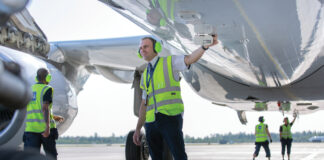

In the 2021 financial year, Dachser increased its consolidated revenue by 26.0% to €7.1 billion. After the lockdown-driven lateral detour of the previous year, the logistics provider is back on a dynamic growth track. The positive outcome for 2021 is due to organic growth in shipments and tonnage of 6.3%, or 7.7% at the Group level. High freight prices, caused by the shortage of load capacity experienced by all carriers, set the seal on this jump in revenue.
“There’s no question that 2021 was exceptional in many ways, with some extreme challenges to overcome,” says Dachser CEO Burkhard Eling. “It was marked by Brexit, the COVID-19 pandemic, and global supply chains pushed to breaking point, all of which caused great uncertainty among our customers. Even in this situation, we managed to offer logistics solutions while still maintaining a high level of quality and service. In this way, we strengthened ties with customers and pursued targeted expansion of business, especially with our major accounts. This was an extraordinary achievement, where the difficult conditions meant that our teams had to give their all.”
Business development in detail
In 2021, air and sea freight business was characterised by supply chain disruptions, a shortage of freight capacity, and correspondingly high rates. As a consequence of this development, the Air & Sea Logistics business field was able to achieve record revenue growth of 78.3%. Shipments handled rose by 9.1% and tonnage jumped 20.9%. One particular success was the further expansion of air freight charters to a network of regular transports between Asia, Europe, and North America. Dachser completed a total of 230 charters in 2021.
“Reliably available freight capacity gives customers planning certainty—and that was the key to our success in 2021. In addition, we were able to feed goods arriving from overseas directly into our own European overland transport network for distribution and delivery, which proved to be very advantageous,” Eling explains.
Strategic and future-oriented action
Volatility and challenges continue to shape the marketplace in 2022. The war in Ukraine is causing extreme human suffering, and will also leave deep marks on the global economy. Then there are the record energy and fuel costs, the further exacerbation of the driver shortage, and persistent disruptions to global supply chains. This last is caused in part by further outbreaks of COVID-19 such as happened recently in China and Hongkong. “We must accept that we’re in for yet another year in which maintaining supply chains will require crisis management, flexibility, and resilience,” Eling says.
Nevertheless, Dachser is also providing for the future by investing in logistics facilities, digital technologies, and equipment. After investing around EUR 100 million in 2021, the company plans to spend some €200 million in 2022. “This includes lighthouse projects such as our fully automated high-bay storage warehouse in Memmingen. Featuring 52,000 pallet spaces, this facility will open in October,” Eling explains. “At the same time, we’re also making substantial investments in digitalisation, climate protection, and especially in our employees—after all, logistics is and will always be a business run by people for people.” In 2021, Dachser hired some 1,000 new employees worldwide, and around 2,200 young people are currently doing an apprenticeship at Dachser locations across the globe. Dachser’s high equity ratio of approximately 60 percent provides strong support for the company’s investment policy.










